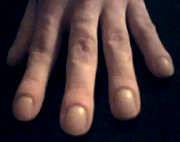PURPOSE: The aim of this study was to investigate pulmonary and cardiovascular responses during the six minute walking test (6MWT) in cystic fibrosis and normal children and to assess the test-retest of 6MWT in the studied population.
METHODS: The subjects recruited were distributed in two groups: cystic fibrosis (CF) and normal group (NG). The study consisted the test-retest of 6MWT by comparing performance on two consecutive 6MWT in both groups. The children had a rest of 30 minutes between the tests. The responsiveness of the 6MWT was determined by assessing the ability of the test to detect changes in exercise capacity. The variables analyzed were distance walked during the test, heart rate overload (% of HR), oxygen saturation (SpO2) and Borg score.
RESULTS: A total of 28 children were recruited in this study, 18 boys and 10 girls. The mean age was 11.53 [+ or -] 2,60 and 10,72 [+ or -] 2,88 years for CF and NG respectively. The mean values for lung volumes were (FEV1= 86.34 [+ or -] 27.11; FRC=94.85 [+ or -] 25.19) for CF and (FEV1=100.99 [+ or -] 8.92; FRC=112.26 [+ or -] 15.56) for NG. The comparison between the groups showed that the distance walked (CF=577.57 [+ or -] 60.22 NG=673 [+ or -] 55.32; p=0.0004) and Borg score(CF=9.92-2.32 CN=12.42 [+ or -] 2.4; p=0.01) were statistically different. However, there were no differences in %HR (CF=72.46 [+ or -] 9.15 NG=72.54 [+ or -] 12.19; p=0,85) and SpO2 (CF=94.07 [+ or -] 5.16 CN=96.28 [+ or -] 2.12; p=0.13) between the groups. The test-retest in cystic fibrosis group showed a significant increase in the walk distance in the second test (p=0.012), the others variables analyzed did not change. In the normal children group just the Borg Score had a significant increase in the second test (p=0,019).
CONCLUSION: There was no difference in heart rate overload in the 6MWT in cystic fibrosis and normal children. However, the cystic fibrosis children had a lower perception of exercise intensity and walked concerning underwear distances when compared with normal children.
CLINICAL IMPLICATIONS: The 6MWT can be applied in cystic fibrosis children as in normal children, however, the cystic fibrosis children has to be previously familiarized with the test.
DISCLOSURE: Cristiane Coelho, None.
Cristiane C. Coelho MA * Dorcas C. Almeida BA Gisele C. Oliveira BA Roberta C. Pinto BA Ivana M. Oliveira MA Evanirso S. Aquino BS Uni-BH, PUC MInas-Betim, Belo Horizonte, Brazil
COPYRIGHT 2005 American College of Chest Physicians
COPYRIGHT 2005 Gale Group



